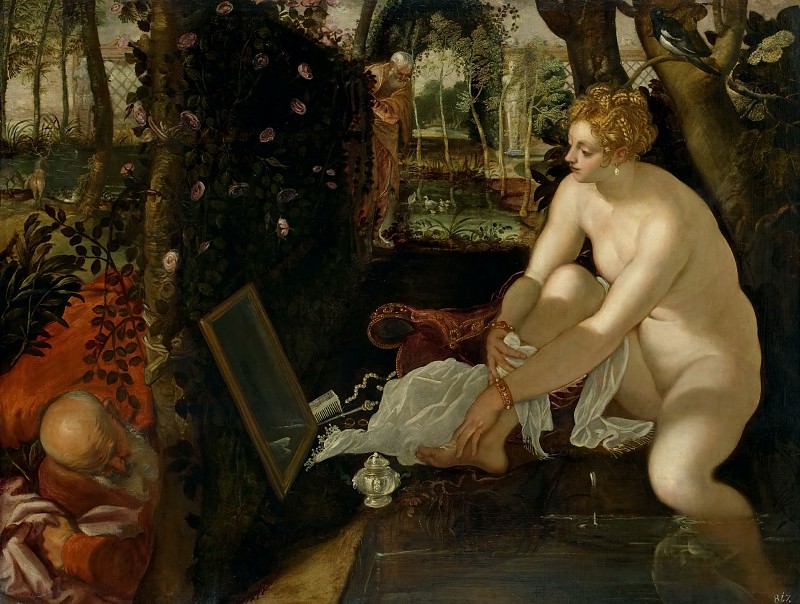Jacopo Tintoretto – Susanna and the Elders Kunsthistorisches Museum
Kunsthistorisches Museum – Jacopo Tintoretto -- Susanna and the Elders
Edit attribution
Download full size: 5487×4141 px (6,8 Mb)
Back to album: Kunsthistorisches Museum
The action of the painting is based on an Old Testament legend. It takes place in Babylon when the Jews ruled there. The woman of a wealthy local resident, Jachim, became the object of the erotic fantasies of two old men. To get what they wanted, the elders set a trap for the beautiful woman in the garden, where she usually bathed unaccompanied. When Susanna took off her clothes, the men ran out of hiding and began to blackmail the heroine.
Description of the painting Tintoretto Susanna and the Elders
The action of the painting is based on an Old Testament legend. It takes place in Babylon when the Jews ruled there. The woman of a wealthy local resident, Jachim, became the object of the erotic fantasies of two old men.
To get what they wanted, the elders set a trap for the beautiful woman in the garden, where she usually bathed unaccompanied. When Susanna took off her clothes, the men ran out of hiding and began to blackmail the heroine. If she refused to sleep with them, they promised to incriminate her and accuse her of adultery, which was then punishable by death.
The woman refused and was arrested on false charges. But the prophet Daniel saved her from execution. He interrogated the elders, found contradictions in their testimony, and rebuked them for lying.
This story was a good excuse for Renaissance artists to depict the naked female body. The scene depicted on the canvas is built around the moment Susannah contemplates pure and virginal nature.
The central figure of the work Susannah and the Elders is a young and completely naked girl. Susanna is holding a white handkerchief, but it is as if she is not even trying to cover her nakedness with it. The realism with which the nude figure of the woman was described and the strength of the granite thigh were decisive in the work of the Italian artist. The girl looks in the mirror, admiring her beauty.
The light gives the figure brightness and volume, highlighting her in all her brilliance, emphasizing the intricate hairstyle, the expensive jewelry on and around the girl. The calmness of the heroine contrasts with the agitation of the elders depicted on the edges of the painting.
The two men placed on the left are depicted in noble garments, as can be seen in the precious yellow-brown damask or the bright red color of the tunic. The author’s distinctive feature is the almost wood-like composition of the upper human arms. The elders stand in ridiculous and awkward poses and peer impatiently out of their hiding places.
The artist used the mirror in front of the heroine to intensify her illumination and make her white skin stand out more. The mirror technique also helped Tintoretto to play with the cortrasts of light and shadow. In general, the action depicted on the canvas resembles the backstage of a theater: the girl and the mirror on the stage platform, and behind the curtains of trees and climbing roses - everything else.
Tintoretto meticulously depicts the smallest objects of Susanna’s toiletry: a comb, a hairpin, an oil amphora, gold and pearls. Although the viewer may contemplate only an episode of this story, knowledge of the ending can give the perception of the work a specific emotional effect.
Кому понравилось
Пожалуйста, подождите
На эту операцию может потребоваться несколько секунд.
Информация появится в новом окне,
если открытие новых окон не запрещено в настройках вашего браузера.
You need to login
Для работы с коллекциями – пожалуйста, войдите в аккаунт (open in new window).




















You cannot comment Why?
To the left, an older man is visible, partially obscured by foliage and draped in vibrant red fabric. He peers intently towards the woman, his expression difficult to decipher – it could be interpreted as curiosity, desire, or even suspicion. An open book lies near him, propped against what seems to be a low wall or ledge, hinting at an intellectual pursuit that is momentarily abandoned.
The garden itself is rendered with dense foliage and a profusion of roses climbing along a wrought-iron fence. The background reveals glimpses of architectural elements – a distant building and statues – suggesting a formal garden setting beyond the immediate foreground. A black bird perches on a branch, its presence adding an element of foreboding or perhaps acting as a symbolic observer of the unfolding events.
The lighting is dramatic, with strong contrasts between light and shadow that accentuate the figures forms and contribute to the overall sense of tension. The pool’s surface reflects the scene above, creating a doubled image and subtly complicating the narrative.
Subtextually, the painting seems to explore themes of vulnerability, observation, and potential transgression. The woman’s pose and averted gaze suggest a sense of unease or exposure. The older mans presence introduces an element of voyeurism and raises questions about power dynamics and moral boundaries. The open book could symbolize knowledge or temptation, while the bird might represent ill omen or divine judgment. The overall effect is one of quiet drama, leaving the viewer to ponder the unspoken narrative unfolding within this secluded garden space.